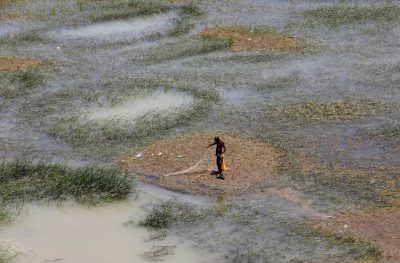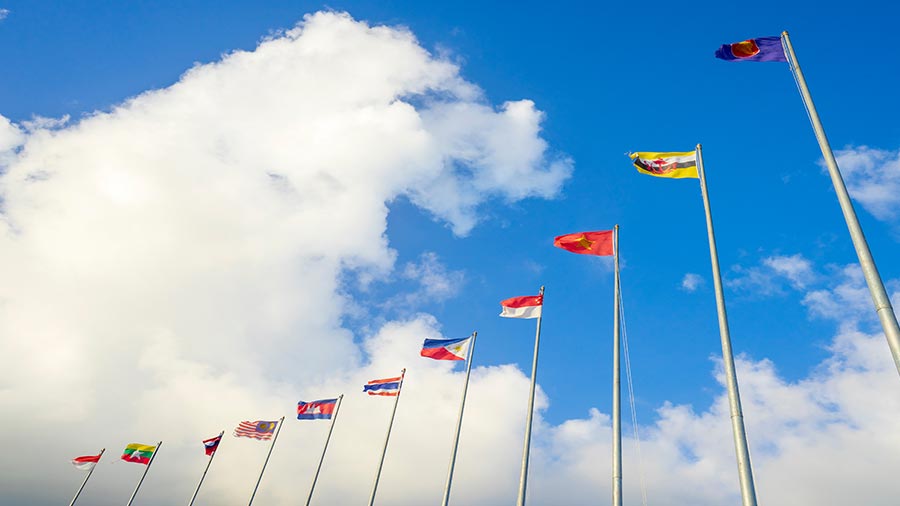China
Smarter strategies for sharing South Asia’s rivers

Author: Ashok Swain, Uppsala University
South Asia is facing severe water scarcity. As the region’s population grows and its economies develop, a lack of sustainable water development strategy is leading to increasingly acute water shortages.
The region is home to nearly 2 billion people, almost half of which depend on the large river systems shared among countries. There are two major international river systems in the region: the Indus and Ganges-Brahmaputra. While the Indus basin is shared by Afghanistan, China, India and Pakistan, the Ganges-Brahmaputra is shared by Bangladesh, Bhutan, China, India and Nepal.
But no regional organisations manage these precious water resources. Instead, water is shared according to bilateral agreements. Notable are the 1960 Indus Treaty between India and Pakistan, the 1996 Ganges Treaty between India and Bangladesh and the 1996 Mahakali Treaty between India and Nepal. India and Bhutan also have a series of hydropower generation agreements.
None of these agreements are comprehensive in scope or nature. The Indus Treaty is primarily a river sharing agreement, while the Ganges Treaty is a water-sharing agreement. The Mahakali Treaty — which is yet to be implemented — is a benefit-sharing agreement.
The South Asian region is water-rich but with huge seasonal variations. In the absence of mutually beneficial, comprehensive agreements to store and develop water resources, there is always a fear that upper riparian countries will unilaterally exploit the rivers for their own benefit. This may have far-reaching effects on downstream countries.
Since 2016, in spite of the 1960 agreement, India has repeatedly threatened to divert water from the Indus away from Pakistan. In the Ganges basin, India has also been diverting water away from Bangladesh since 1975, though that diversion is presently regulated under the 1996 Agreement. India has also made proposals to divert water from the Brahmaputra inland, instead of allowing water to flow into Bangladesh.
After becoming the prime minister of India in 2014, Narendra Modi revived old plans to link 30 of the country’s major rivers and divert the Ganges-Brahmaputra. This grand plan intends to provide water to India’s arid provinces — but it is causing anxiety among the country’s smaller neighbours. Some rivers have already been connected, but the proposal requires the construction of large dams in India, Nepal and Bhutan in order to go ahead, as they share the Ganges-Brahmaputra. This will require India to enter into agreements with these countries.
Linking major rivers of the region could create more regional water disputes instead of resolving the existing ones. In South Asia, failure to find negotiated settlements over water in the past has contributed to the rise of tensions between states. Only in the case of the 1960 Indus Treaty did India and Pakistan accept mediation by the World Bank. In all other water disputes, India has strictly adhered to the practice of bilateral negotiation. Though this approach has strengthened India’s position as a regional power, it has kept the past disagreements alive and limited wider plans to develop the region’s water resources.
The growing threat of climate change and its impact on water demand and supply in the region means South Asian countries can no longer continue with the old bilateral approach — particularly given China’s growing interest in harnessing river resources. In the last decade, China has built two hydropower dams on the Indus and Brahmaputra, and two more dams are presently under construction. All these developments have further increased the dynamics of water conflict, as well as the need for India to cooperate over the region’s scarce shared water resources.
China’s water projects upstream have threatened India’s position as the dominant riparian in these two basins. This has prompted India to explore collaborating with Bangladesh, Bhutan and Nepal in the Ganges-Brahmaputra basin, and to seek support for dam-building in the Afghan part of the Indus basin.
Riparian countries in South Asia should work towards establishing lower basin-based water management institutions — as the lower basin countries in the Mekong basin have been doing since the 1990s. Cooperation among lower riparian countries is needed not only to address increasing water scarcity in the dry-seasons and devastating floods in the monsoon periods, but also to effectively protect their water supply from China. Unilateral actions by South Asian countries, particularly India, to protect…
Business
Gordonstoun Severs Connections with Business Led by Individual Accused of Espionage for China

Gordonstoun school severed ties with Hampton Group over espionage allegations against chairman Yang Tengbo. He denies involvement and claims to be a victim of political tensions between the UK and China.
Allegations Lead to School’s Decision
Gordonstoun School in Moray has cut ties with Hampton Group International after serious allegations surfaced regarding its chairman, Yang Tengbo, who is accused of being a spy for the Chinese government. Known by the alias "H6," Mr. Tengbo was involved in a deal that aimed to establish five new schools in China affiliated with Gordonstoun. However, the recent allegations compelled the school to terminate their agreement.
Public Denial and Legal Action
In response to the spying claims, Mr. Tengbo publicly revealed his identity, asserting that he has committed no wrongdoing. A close associate of Prince Andrew and a former Gordonstoun student himself, Mr. Tengbo has strenuously denied the accusations, stating that he is a target of the escalating tensions between the UK and China. He has claimed that his mistreatment is politically motivated.
Immigration Challenges and Legal Responses
Yang Tengbo, also known as Chris Yang, has faced additional challenges regarding his immigration status in the UK. After losing an appeal against a ban enacted last year, he reiterated his innocence, condemning media speculation while emphasizing his commitment to clear his name. Gordonstoun, on its part, stated its inability to divulge further details due to legal constraints.
Source : Gordonstoun cuts ties with business chaired by man accused of spying for China
Business
China Dismantles Prominent Uyghur Business Landmark in Xinjiang – Shia Waves

The Chinese government demolished the Rebiya Kadeer Trade Center in Xinjiang, affecting Uyghur culture and commerce, prompting criticism from activists amid concerns over cultural erasure and human rights violations.
Demolition of a Cultural Landmark
The Chinese government recently demolished the Rebiya Kadeer Trade Center in Urumqi, Xinjiang, a vital hub for Uyghur culture and commerce, as reported by VOA. This center, once inhabited by more than 800 predominantly Uyghur-owned businesses, has been deserted since 2009. Authorities forcibly ordered local business owners to vacate the premises before proceeding with the demolition, which took place without any public notice.
Condemnation from Activists
Uyghur rights activists have condemned this demolition, perceiving it as part of China’s broader strategy to undermine Uyghur identity and heritage. The event has sparked heightened international concern regarding China’s policies in Xinjiang, which have been characterized by allegations of mass detentions and cultural suppression, prompting claims of crimes against humanity.
Rebiya Kadeer’s Response
Rebiya Kadeer, the center’s namesake and a notable Uyghur rights advocate, criticized the demolition as a deliberate attempt to erase her legacy. Kadeer, who has been living in exile in the U.S. since her release from imprisonment in 2005, continues to advocate for Uyghur rights. She has expressed that her family members have suffered persecution due to her activism, while the Chinese government has yet to comment on the legal ramifications of the demolition.
Source : China Demolishes Uyghur Business Landmark in Xinjiang – Shia Waves
China
China Expands Nationwide Private Pension Scheme After Two-Year Pilot Program

China’s private pension scheme, previously piloted in 36 cities, will roll out nationwide on December 15, 2024, enabling workers to open tax-deferred accounts. The initiative aims to enhance retirement savings, address aging population challenges, and stimulate financial sector growth.
After a two-year pilot program, China has officially expanded its private pension scheme nationwide. Starting December 15, 2024, workers covered by urban employee basic pension insurance or urban-rural resident basic pension insurance across the country can participate in this supplementary pension scheme. This nationwide rollout represents a significant milestone in China’s efforts to build a comprehensive pension system, addressing the challenges of a rapidly aging population.
On December 12, 2024, the Ministry of Human Resources and Social Security, together with four other departments including the Ministry of Finance, the State Taxation Administration, the Financial Regulatory Administration, and the China Securities Regulatory Commission, announced the nationwide implementation of China’s private pension scheme effective December 15, 2024. The initiative extends eligibility to all workers enrolled in urban employee basic pension insurance or urban-rural resident basic pension insurance.
A notable development is the expansion of tax incentives for private pensions, previously limited to pilot cities, to a national scale. Participants can now enjoy these benefits across China, with government agencies collaborating to ensure seamless implementation and to encourage broad participation through these enhanced incentives.
China first introduced its private pension scheme in November 2022 as a pilot program covering 36 cities and regions, including major hubs like Beijing, Shanghai, Guangzhou, Xi’an, and Chengdu. Under the program, individuals were allowed to open tax-deferred private pension accounts, contributing up to RMB 12,000 (approximately $1,654) annually to invest in a range of retirement products such as bank deposits, mutual funds, commercial pension insurance, and wealth management products.
Read more about China’s private pension pilot program launched two years ago: China Officially Launches New Private Pension Scheme – Who Can Take Part?
The nationwide implementation underscores the Chinese government’s commitment to addressing demographic challenges and promoting economic resilience. By providing tax advantages and expanding access, the scheme aims to incentivize long-term savings and foster greater participation in personal retirement planning.
The reform is expected to catalyze growth in China’s financial and insurance sectors while offering individuals a reliable mechanism to enhance their retirement security.
| This article was first published by China Briefing , which is produced by Dezan Shira & Associates. The firm assists foreign investors throughout Asia from offices across the world, including in in China, Hong Kong, Vietnam, Singapore, and India . Readers may write to info@dezshira.com for more support. |
Read the rest of the original article.






